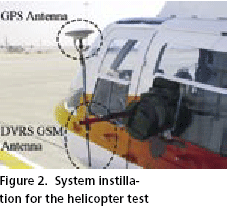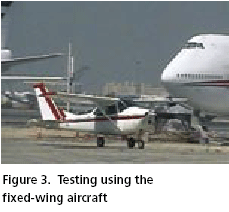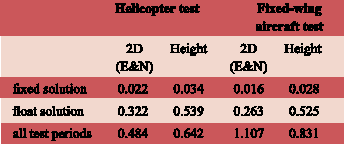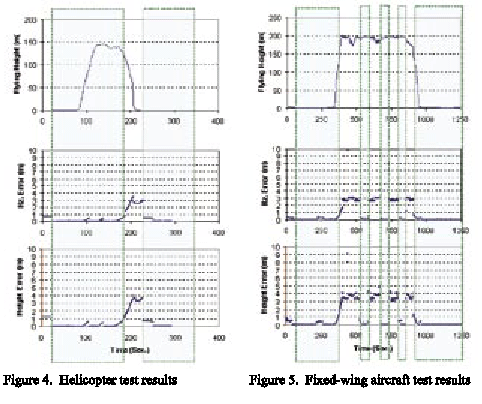| Mycoordinates | |
Multiple reference station GPS networks for airborne navigation
Testing the DVRS systemSeveral flight tests were conducted to study the use of the DVRS network for aircraft navigation. Two types of aircraft were used, a helicopter and a small fixed-wing airplane. A dual-frequency GPS rover receiver (Leica SR530) equipped with a DVRS GSM modem to receive the DVRS corrections was used. The test included the aircraft takeoff, enroute flying, landing and airport surface navigation. The data were processed at one-second intervals. In the helicopter test, the GPS and GSM antennae were rigidly mounted on an arm approximately 0.9 m long extending outside the helicopter. The arm was attached to a frame rigidly fixed inside the helicopter. No arm vibration was experienced during flight. For better GPS as well as GSM signal reception during testing, the GPS antenna was mounted high on the arm for better visibility of the sky, while the GSM antenna faced down. Figures 2 and 3 show the system installation on the aircrafts. For the fixed-wing aircraft test, the GSM antenna was installed inside the aircraft, which is acceptable for GSM communication. Both tests were carried out over the city of Dubai. Figure 4 and 5 show the helicopter and the fixed-wing aircraft flying height and the 2-D and height positioning accuracies achieved during testing. The DVRS corrections were continuously received (dashed region in the Figures) during major parts of airport surface navigation, takeoff, enroute flying, landing and parking. During some periods, temporary loss of the signals took place. This can be mainly attributed to the use of GSM signals in sending the DVRS data, and partially to changes in the aircraft dynamics. In general, the carrier phase measurement ambiguities were resolved as integers and the average positioning accuracy, represented by coordinate standard deviations, were on the cm-level as shown in Table 2. During the periods where the DVRS corrections were received but the ambiguities were resolved in a float solution, the positioning accuracy was at the sub-meter level. However, when the DVRS signals were not received, errors grew to more than 3.5 m, which are only suitable for category I navigation (enroute flying). Solutions to the problem of breaks in reception of network correctionsIntegration with the Inertial systemOne method to increase the availability of the positioning accuracy at the required level is to integrate GPS with an Inertial Measuring Unit (IMU). For testing purposes and due to hardware availability, a Honeywell tactical-grade (medium accuracy) IMU system of approximately 1-10 degrees/hour gyro drift was used. For simplicity, the GPS/INS integration was carried out in a decentralized loose coupling scheme. In this approach, the GPS and IMU (INS) filters ran independently in parallel. An adaptive Kalman filtering approach was employed in the processing of the test data. An integrated GPS/INS system is also beneficial in the sense that it gives high frequency output. In addition, the INS is useful for determination of the attitude information of the aircraft, as well as cycle slip detection and repair, and ambiguity resolution, if a centralized filtering scheme is used. The test results showed that the accuracy requirements for precision approach (category III) were generally achieved up to 25-31 seconds of the GPS data outages. This was dependent to some extent on the aircraft dynamics. Prediction of the measurement corrections as a time seriesIntegration of GPS with an Inertial Measuring Unit (IMU) to bridge positioning during short breaks in reception of corrections is only a valid solution for a short period. This is due to the rapid deterioration of the IMU positioning accuracy in the standalone mode, as well as the increased cost and complexity of the hardware and software involved. Another approach is proposed for this task where all error components including corrections to the wet tropospheric error, the satellite orbital and clock errors are individually estimated at the rover. During data reception from the reference stations, the corrections are continuously modeled as a time series and accurately predicted for several minutes ahead. The double exponential and ARIMA models were used for this purpose. When a loss of reception of the reference station data takes place, predicted measurement corrections are added to the un-differenced observables, and accurate positioning is carried out in an autonomous precise pointpositioning mode. Testing of this method showed that after 10 minutes of prediction, the positioning errors were still in the range of a few decimetres, and it was sufficient for Category III of navigation. ConclusionsThe test results show that the use of RTK multi-station reference networks (e.g. the DVRS network) in precise aircraft navigation is feasible, particularly for the airport area. This new technology can increase the coverage area compared with other GPS-navigation systems, such as airport LAAS, with significant cost reduction. Small airports can thus benefit from this service. Efficient methods for bridging positioning should be implemented when reception of network corrections is interrupted. This can include integration with IMU or predicting the measurement corrections as a time series. |
|||||||||||||||
|
|||||||||||||||
|
Pages: 1 2
















 (No Ratings Yet)
(No Ratings Yet)





